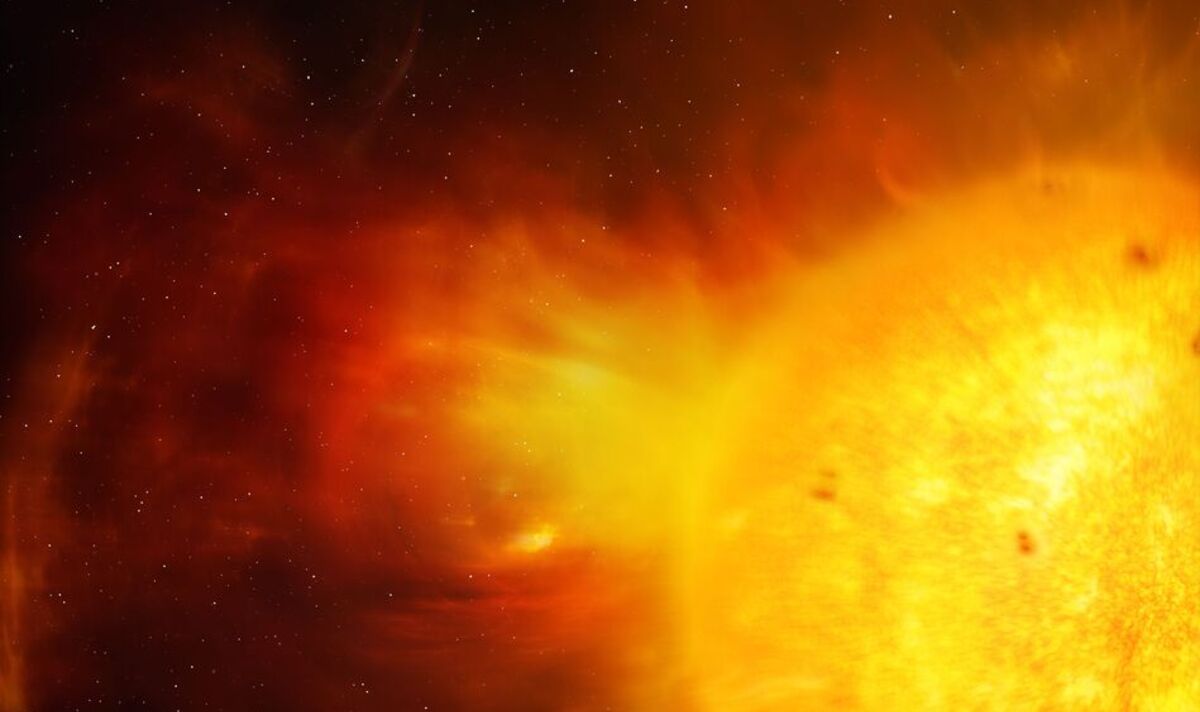Earth’s ‘magnetic song’ captured during solar storm
A “major” solar storm warning has been issued, as we face an “Earth-directed” blast of plasma that is expected to cause GPS and radio interference. According to experts, the storm appears to be associated with a “significant” explosion on the farside of the Sun yesterday. The European Space Agency’s Solar and Heliospheric Observatory (SOHO) observed a very bright and fast coronal mass ejection billowing away from the Sun’s south-eastern limb. (One of the most powerful forms of solar storm, coronal mass ejections occur when the Sun belches out a cloud of charged particles and electromagnetic fluctuations.) Alongside this, NASA’s Solar Dynamics Observatory detected shockwaves from the blast wrapping around both of the Sun’s poles — likely indicative, spaceweather.com have said, of a “very powerful explosion — possibly an X-flare.” They added: “Radiation from the flare was eclipsed by the edge of the sun, reducing its intensity by one to two orders of magnitude, so that Earth-orbiting satellites detected only a C4-class event.”
Los Angeles-based physicist and space weather expert Dr Tamitha Skov tweeted that on the Sun “a new region — likely to be named 3182 — fires up a huge flare on the Sun’s farside.
“[It] will cause R1-level radio blackout risk to rise up from 35 percent this week. S1-level radiation storm risk at 5 percent [for the] next three days.”
Radio blackouts are categorised on a five-point scale. R1 is the lowest, with a severity that the US National Oceanic and Atmospheric Administration (NOAA) classifies as “minor”.
Similarly, solar radiation storms are also categorised on a five-point scale by NOAA. S1 is “minor”, with no impact on satellite operations and “minor impacts on high-frequency radio in the polar regions”.
However, Dr Skov went on to add: “An Earth-directed solar storm hits now followed by fast solar wind. Expect nightside GPS and amateur radio issues. Aurora possible to mid-latitudes through January 7.”

A ‘major’ solar storm warning has been issued, as we face an ‘Earth-directed’ blast of plasma (Image: Getty Images)

Dr Skov said: ‘Aurora possible to mid-latitudes through January 7’ (Image: Twitter / @TamithaSkov)
The aurora are natural light shows generated when particles from the solar wind excite atoms in Earth’s upper atmosphere, making them glow.
When seen in the northern hemisphere, they are known as the aurora borealis, whereas their antipodean counterparts are called the aurora australis.
The aurora form curtains of light that follow the geomagnetic field lines — and appear in different colours depending on which atoms are being excited.
The two primary gases in the Earth’s atmosphere are oxygen, which emits a greenish light, and nitrogen, which appears in hues of blue, pink and purple.
READ MORE: Kepler telescope shows ‘glitches’ occur in core of red giant stars

The storm appears to be associated with a “significant” explosion on the far side of the Sun (Image: spaceweather.com)

NOAA said: ‘A coronal mass ejection occurred from just beyond he east limb on January 3’ (Image: NOAA)
Last night, a NOAA spokesperson said: “A coronal mass ejection occurred from just beyond the east limb on January 3, 2023. This coronal mass ejection appeared to be associated with a C3 flare at 03/0646 UTC.
“The flare was observed in GOES SUVI [Solar Ultraviolet Imager] imagery and appeared to emanate from an active region just beyond the east limb.
“National Solar Observatory/Global Oscillation Network Group helioseismology data indicated a likely active region about one day or so from rotating onto the visible solar disk.
“Since coronal mass ejections can expand considerably during their interplanetary transit, this coronal mass ejection was analysed closely and monitored. Results indicated a passage most likely to be behind Earth’s orbit on January 6.”
DON’T MISS:
Covid variant to ‘watch out for’ in 2023 as US cases soar [INSIGHT]
China accused of cover-up as Beijing denies failure of ‘Zero-Covid’ [REPORT]
Scientist’s explanation as to why Covid cases will peak this month [ANALYSIS]
A coronal mass ejection in the September of 1859 caused the most powerful geomagnetic storm on record — one which scientists refer to as “the Carrington Event”.
The storm affected telegraph networks across Europe and North America, as well as the recently-lain transatlantic link that connected them.
Currents generated in cables by the space weather event reportedly caused telegraph pylons to spark, operators to receive electric shocks and some lines to fail completely.
Other connections, meanwhile, were found to still operate even once their power had been cut, so strong were the electrical currents induced by the storm.

Pictured: an infographic on the Sun (Image: Express.co.uk)
According to a study presented at the Association for Computing Machinery (ACM)’s SIGCOMM 2021 conference, a large solar storm like the Carrington Event could have the potential to cripple the Internet for weeks.
Unlike Victorian-era telegraph lines, the fibre optic cables that make up the backbone of the Internet are immune to the electromagnetic fluctuations caused by solar storms.
The same cannot be said, however, for the signal boosters that are dotted along undersea cables in order to maintain connections over long distances.
And being underwater, not only are these long-distance cables more vulnerable to the impacts of space weather, but they are also inherently harder to access for repairs.
Astrophysicists predict that there is a 1.6–12 percent chance a solar storm powerful enough to cause catastrophic disruption to modern society will strike the earth in the next 10 years.

